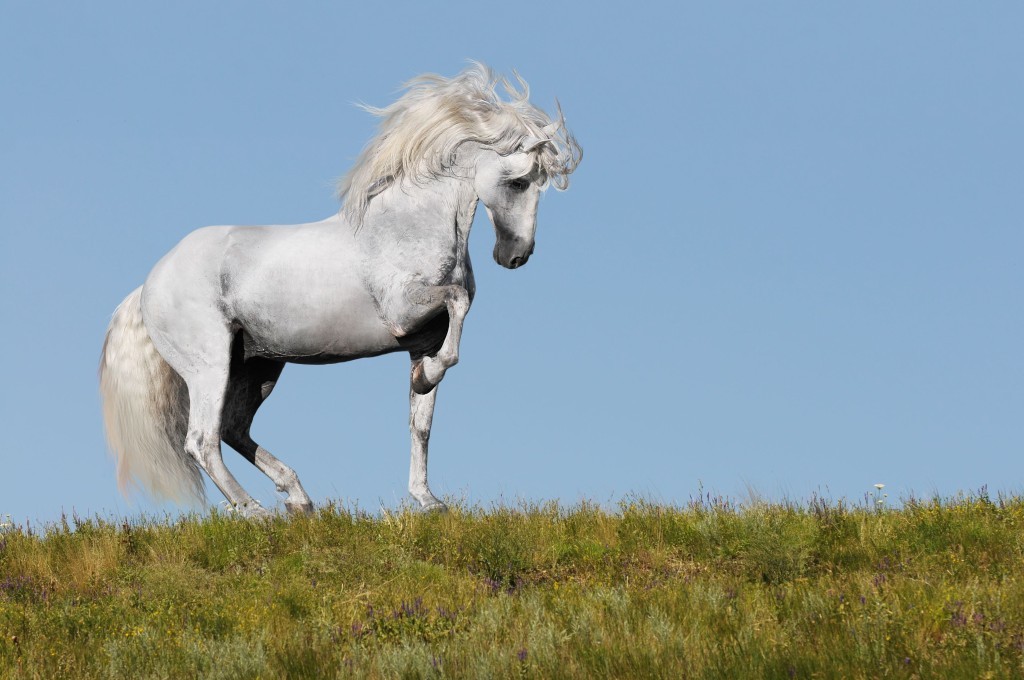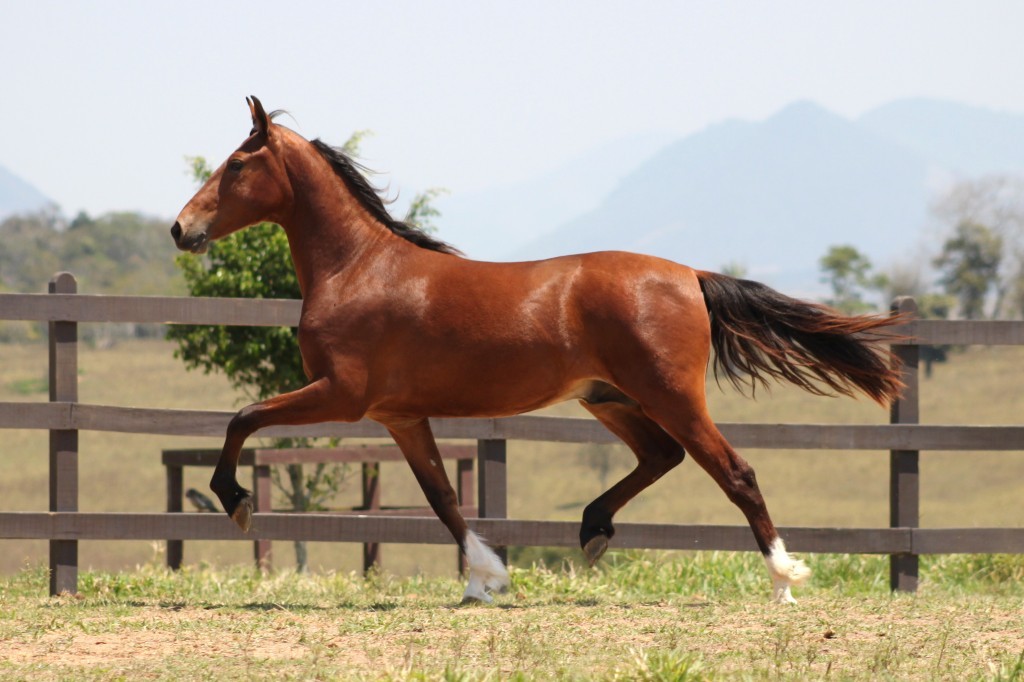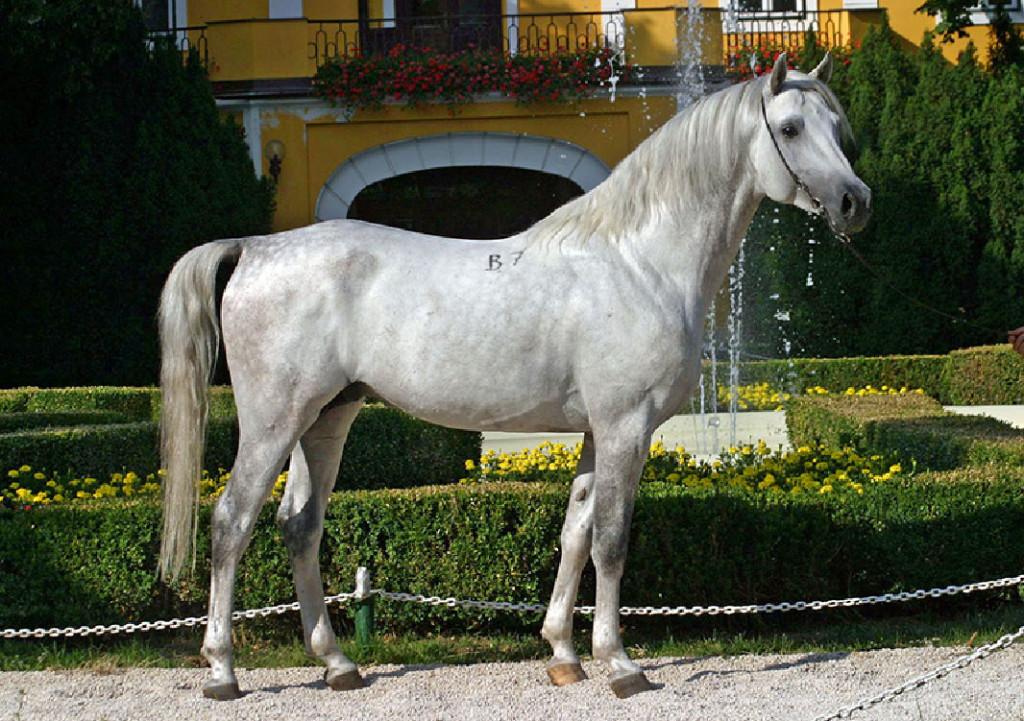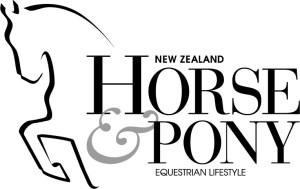
Andalusian, Spain
It’s hard to imagine anything more glamorous than an Andalusian! If proudly arched necks and romantically swirling manes and tails are your thing, then this is the absolute horse of your dreams. They’re properly known as the Pure Spanish Horse or PRE (the initials stand for Pura Raza Española, which translates to ‘pure-bred Spanish’) and the Caballo Espanol (‘Spanish horse’).
Whatever they’re called, these horses are gorgeous and for hundreds of years were considered to be the epitome of equine perfection. They have influenced numerous other breeds, including many warmbloods.
What is a typical Andalusian? Power, majesty and magnficence, combined with a kind and willing nature, a mind that loves to learn and fabulously extravagant movement – the original dressage horse of the world. They’re chunky but super-elegant, and very athletic to ride. Andalusians are often grey, but can be just about any other colour, and are not very big – around 15hh is the average. They’ve been around for 600 years or more, and still look just the same as they did when they were ridden by kings and aristocrats. Yes, these gorgeous creatures are in a class of their own. Olé!

Azteca, Mexico
Aztecas are quite new (they date from the 1970s) and have three main breeds in their bloodlines – the criollo (a tough little cowboy horse of Spanish descent), the quarter horse, and the Andalusian, which they resemble strongly.
Their noses are straight or slightly Roman, they have magnificently arched necks, silky coats and long manes and tails, they are between 14.1 and 15.3hh and they come in any ‘solid’ colour. They were developed by Mexican churros (cowboys) and their original use was as cattle horses, as they are smart, fast, calm, responsive and very quick on their feet, but their talents have become well known among other riders who love them for their abilities in dressage, jumping and other disciplines. The Americans like them so much that they’ve developed their own ‘sub-breed’, the American Azteca!
Although they’ve only been around for 43 years, these super little equines have been given the exalted title of National Horse of Mexico.

Cleveland Bay, England
Cleveland Bays are not enormously tall (about 16-16.2hh) but they are enormously powerful: built like a tank, with shortish legs, a big, wide back, very strong neck and loads of muscle. They are always bay – ideally, bright (red) bay. To be accepted into the CB studbook, the only white marking they’re allowed is a small white star, and their legs should have proper black stockings, with no feathers.
Cleveland Bays are one of the most ancient breeds in Britain (if not the most ancient of all) and are definitely not draught horses, although they are often used as coach horses. Their original job was to carry people and goods around the Yorkshire countryside – the medieval equivalent of a travelling salesman’s car! They’re very versatile: great jumpers and hunters and good at dressage.
Not long ago, these beautiful horses were almost extinct, but these days they have admirers around the world. They’re a popular breeding cross (especially with thoroughbreds), creating top sporthorses. There have been quite a few CBs in New Zealand over the years, and there is at least one purebred stallion here now; his name is Silver Fern Blue Jeans and he lives near Nelson.

French Trotter, France
This horse is a native of Normandy, where (it’s generally agreed) the best trotters in the world are bred. French Trotters are born athletes, with lovely kind natures and very attractive looks. They can be quite tall (17hh) or quite small (15hh) and are usually bay, chestnut or brown. They have a handsome head with a straight nose, their chests are big and deep, and their wide rumps are packed with power.
Obviously, they are used for racing…at an extremely fast trot! They must pass a 1km speed test before they are allowed to race or breed, and, unlike here in New Zealand, where all trotters race in harness (pulling a lightweight cart or ‘sulky’), French Trotters often compete with a jockey on board. It’s quite a sight!
As you probably know, trotters in most parts of world are standardbreds. French Trotters are different altogether, with only a small amount of standardbred blood. Instead, they have the thoroughbred, Norman Horse (now extinct) and Norfolk Roadster (also now extinct) in their ancestry.

Kaimanawa, New Zealand
No need to tell you where this breed comes from ☺ All horse-and-pony-mad New Zealanders are aware of the fact that these are our very own equines. These days, there is probably a Kai or part-Kai at every pony club in the land, and their popularity is growing briskly, thanks to the efforts of fantastic people like the Kaimanawa Heritage Horses charitable trust, and of course, the Wilson sisters.
Although strictly speaking they are not ‘native’ ponies, they certainly evolved in this country – and from an amazing mix of breeds, including Exmoor, Welsh and thoroughbred. Yes, you might think thoroughbred is bit unlikely, but actually their genes have more in common with TBs than with any other type of horse!
Kaimanawas are usually around 14hh, strong and sturdy with a short neck and straight shoulders. However, it’s impossible to pinpoint a totally typical Kai, as there isn’t typical Kai ‘look’. They can be much smaller or much taller than 14hh, with straight noses, Roman noses – even dish noses. Some have thicker coats than others, some have finer legs, and they can be any colour. But, what almost all of them have in common is a sensible, kind temperament.

Kladruby or Kladruber, Czech Republic
With their super-sized Roman noses, Kladrubys are not every horse lover’s idea of handsome, but we think they’re adorable… and we totally want to hug one of those crazy big heads!
The breed hasn’t changed much in 400 years, which means that horses exactly like these were trotting around Europe when Shakespeare was a boy.They come from the world’s oldest major breeding establishment, the Czech Republic’s Kladruby National Stud, and those amazing noses are inherited from ancestors whose types have long since died out, leaving the Kladruby alone in the world – and (need we say it?) unique. Naturally, they are VERY carefully bred these days.
These tall, dignified softies are famous for their niceness, but there’s more to them than that. They have an eye-catching, high-stepping trot and are always grey or black, standing from 16.2hh to 17hh or more. The greys were used as ceremonial horses (they’re still popular for this in Austria, Denmark and Sweden). Black Kladrubys are a little smaller and were traditionally used by priests and church dignitaries. These days, both colours can be seen working as police horses in Prague, the capital city of their homeland.
 Mangalarga Marchador, Brazil
Mangalarga Marchador, Brazil
We need a brass band playing military music to introduce this magnificent marching breed! It is the National Horse of Brazil and a Brazilian National Treasure, so maybe we will see some on show at the next Olympic Games. Fingers crossed, because Marchadors are beautiful, proud-looking horses who are born with two special ‘marching’ gaits. The first of these, the marchapicada is a bustling but smooth amble, and the second, the marchabatida is a kind of broken trot – not at all like the type of trot we’re used to!
Every Marchador is descended from a stallion called Sublime (who had regal Portuguese blood) and they have been wowing people since the 1800s. They are strong, athletic and very versatile, so are used for a variety of sports, ranging from polo to endurance and jumping (yes, these talented creatures can jump really well). They are also superb cattle horses. Their temperaments are alert but gentle and obedient – fantastically good, in fact! Add this to their beauty and silky coat, and there’s just about nothing wrong with these South Americans.
Marchadors are usually grey or chestnut, but come in other colours too, and are not very tall: between 14.2hh and 16hh is the average.

Normandy Cob, France
Being on board one of these gorgeous, chunky horses is like sitting on a very large armchair: they have ultra-smooth action. Another of their quite surprising characteristics is elegance. They have a very great amount of it, which often leads people to mistake them for draught-TB crosses. And, although most of us think of cobs as being short and stocky, somewhere between 14.2hh and 15.1hh, these big beauties are a full two hands higher – 16.2hh is average!
Normandy Cobs come in a couple of basic types: heavy (for riding) and heavier (for farm and harness work). They’re never as enormous as a true draught horse, and this makes them much more practical to saddle up and sit on.
With handsome heads, arched necks and a load of presence, they catch eyes wherever they go. Like their cousins, the French Trotters, they are usually chestnut, bay or brown.

Selle Français, France
Mais oui! This is the number-one glamour horse of France, excelling in all equestrian disciplines, but especially brilliant at show jumping. This equine athlete has the blood of Normandy Trotters and Norman Cobs flowing through its aristocratic veins! Of course, there is plenty of TB in there too, as well as a few other French breeds, and all of them add up to a horse with superb good looks.
The Selle Français is also known as the French Saddle Horse, and was created purely for sport, becoming more and more beautiful and talented over the two centuries that it’s been in existence. These days the breed is popular all over the world, including in New Zealand.
So, what does this amazing creature look like? Let’s sum it up in two words: all class! Although a warmblood, SF’s are lighter and finer than most others of this type, and are often used to ‘refine’ other warmbloods. They are usually rather tall – often around 17hh – and have a fine, straight head and wide forehead.

Shagya Arabian, Hungary
This is an Arabian with a difference: the highly prized Shagya (pronounced shay-gee-ah).
They are still bred mainly in Austria and the Eastern European countries, and because they have a tiny bit of non-Arab blood from ages past, they are not strictly speaking pure Arabians. However, they certainly look like Arabs – or perhaps we should say they look like Arabs who have been enlarged in all directions! They have bigger bones than their desert cousins, and are noticeably taller – usually around 16hh. They are multi-talented and gorgeous individuals, excelling at endurance, jumping and just about any other horse sport you can think of, and are now well established in countries around the world as a completely separate breed.
We don’t think there are any in New Zealand, but there certainly is Shagya blood in the veins of some NZ horses, thanks to a sire called Polarschnee, a famous Trakehner who had Shagya ancestors. He was at stud here in the 1980s and one of his sons was Andrew Nicholson’s Olympic bronze medallist, Jagermeister.

Standardbred, USA
Standies are super, and they are also one of the most underrated breeds in the world. Bred to race in harness but happy with just about any work, they can do well in a range of disciplines, though it’s true that the ones who are natural pacers aren’t so great at dressage!
Where does the name come from? When the breed was being developed back in the 1800s, horses had to prove they could trot a mile (1.6km) in a ‘standard’ time, two and a half minutes, in order to be registered. They go much faster than that now; most of them can trot that distance in less than two minutes.
Standardbreds have thoroughbred blood in them, but are a little heavier and longer-bodied than their cousins and not usually as tall. Because they like being with people, they are normally very easy to train, and their calm temperament makes them a lovely horse to own. They come in all the same colours as TBs, but are most often bay.






